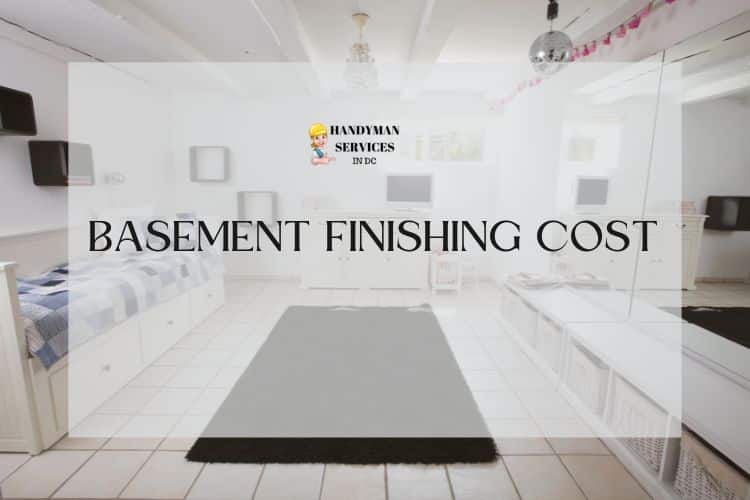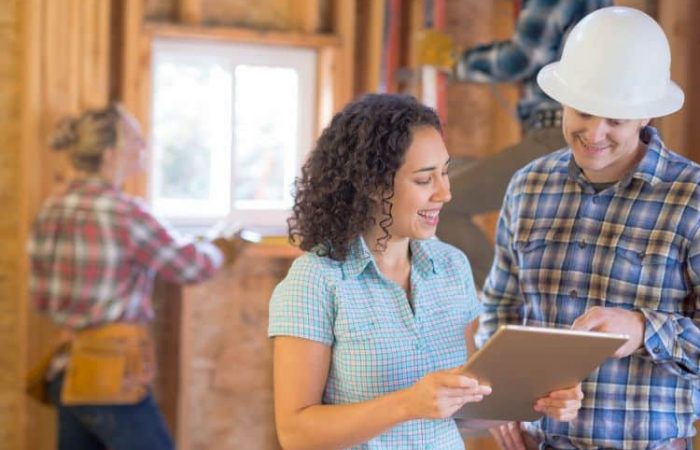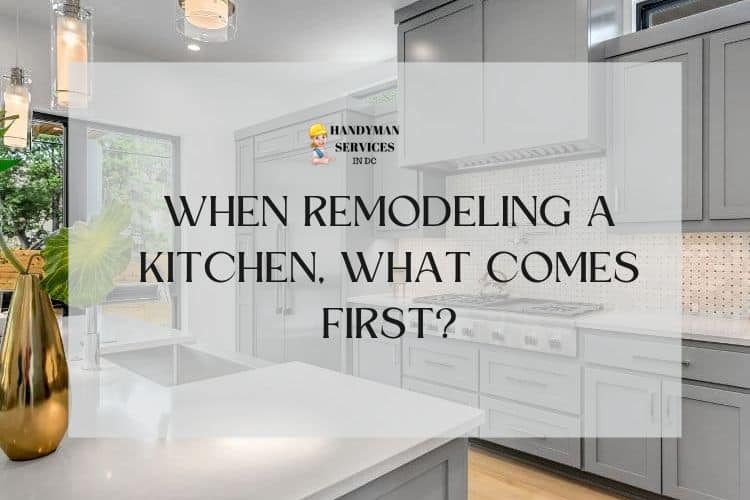The average basement finishing costs are between $6,500 and $60,355. However, the project cost can vary significantly depending on your basement’s square feet and condition and the type of finishes you select.
Basement Finishing Cost
Basement finishing-what is it?
Basement finishing is the process of creating additional living space in your basement. This can include adding new rooms, walls, floors, ceilings, and fixtures. Basement remodeling is a great way to add value to your home and increase your living space. There are many reasons to finish your basement, including:
- Adding extra living space for your family
- Increasing the value of your home
- Creating a more comfortable living environment
- Adding privacy for your family
- Adding an extra bedroom, bathroom, or home office
A finished basement project is not a do-it-yourself home improvement project. It requires the expertise of a qualified basement contractor. A finished basement adds value to your home and can be an excellent asset for your family. But before you begin, there are a few things you should know about basement remodeling.
Basement Finishing Costs:
The cost of finishing your basement will vary depending on the size of your basement, the materials you use, and the extent of the work that needs to be done. However, on average, you can expect to spend between $6,500 and $60,355 to finish your basement.
Basement Finishing Plans:
Before you begin your basement remodeling project, it’s essential to have a plan. You’ll need to decide what rooms you want to add, what materials you’ll use, and how much work needs to be done. Once you have a plan, you can shop for contractors and get quotes.
Basement Materials:
The materials you use will significantly affect the cost of your basement remodeling project. Basement finishing systems include everything from the walls and floors to the ceiling and fixtures. These systems can be expensive but are the easiest way to finish your basement.
If you’re on a budget, you can still finish your basement using some cheaper materials. For example, instead of using drywall, you can use paneling. And instead of adding new flooring, you can paint the existing concrete flooring.
Basement Finishing Tip:
Hire a qualified contractor: Basement finishing is not a do-it-yourself project. You'll need to hire a qualified basement contractor to do the work for you. Get references and check out their previous work before hiring anyone.
Factors that affect the cost of finishing your basement:
The basement square foot
The square foot of your basement will significantly impact the cost of finishing it. A larger space will require more materials and labor, making it more expensive to finish. If you have a very small basement, it may not be worth finishing because the costs would be too high concerning the usable space you would gain.
The basement Condition
The condition of your basement also plays a role in the cost of finishing it. If your basement is already in good condition, with few repairs, the cost will be lower than if your basement needs extensive work, such as waterproofing or mold remediation.
Materials
The materials used for the newly finished basement project will also affect the cost. Finished basements include everything from the walls and floors to the ceiling and fixtures. These systems can be expensive but are also the easiest way to finish your basement. If you’re on a budget, you can still finish your basement using cheaper materials, such as paneling instead of drywall or painting the existing concrete floor instead of adding new basement flooring.
The basement walls
The type of walls in your basement will affect the finishing cost. If you have poured concrete walls, they will need to be waterproofed before being finished. This can add to the overall cost. If your basement has cinderblock walls, they’ll need to be covered with drywall or paneling.
The basement ceiling
The ceiling is another factor that affects the cost of finishing your basement. If your basement has an exposed ceiling, it must be insulated and finished with drywall or paneling. This can add significantly to the cost. If you have a drop ceiling, it will be much easier and less expensive to finish.
The basement flooring
The flooring you choose will also affect the cost of finishing your basement. If you want to install new floorings, such as carpet, tile, or hardwood, the cost will be higher than if you simply paint the existing concrete floors.
Labor
The labor costs associated with finishing your basement will depend on the size and scope of the project. If you’re doing a simple finish, such as painting and adding a new carpet, the labor costs will be lower than if you’re adding new rooms or doing a complete gut job.
Building permit
You will likely need to pull a permit for your basement finish project. The cost of the permit will depend on the scope of the work and your location.
The remodeling plan
The final cost of finishing your basement will depend on the project’s scope. If you’re only finishing a small portion of the basement, such as one room, the costs will be lower than if you’re finishing the entire space. The more complex the project, the higher the cost will be.
Basement finishing cost breakdown
The table below shows a breakdown of the average cost to finish a basement, depending on the size and scope of the project.
Basement Size Cost
- Small (less than 600 square feet) $6,000 – $18,000
- Medium (600-1,000 square feet) $15,000 – $27,500
- Large (more than 1,000 square feet) $25,000 – $50,000
Cost Per Square Foot
Basement finishing costs range from $10 to $35 per square foot. For lower-end finishes, such as painting and new carpet, the cost will be on the lower end. For higher-end finishes, such as adding new rooms or a complete gut job, the cost will be on the higher end.
Cost Breakdown
| Item | Price |
|---|---|
| Flooring | $5 - $12 per square foot |
| Paint | $0.50 - $2 per square foot |
| Drywall | $1 - $4 per square foots |
| Carpet | $3 - $7 per square foot |
| Tile | $5 - $15 per square foots |
| Hardwood Flooring | $8 - $20 per square foot |
| Labor | $40 - $80 per hour foot |
| Framing | $8 - $16 per square foot |
| Electrical | $25 - $50 per hour |
| Plumbing | $50 - $100 per hour |
| Building permit | Several hundred dollars, on average |
Basement remodel Tip
Get multiple quotes: Once you've decided what you want to do, get multiple quotes from different contractors. This will help you compare prices and find the best deal.
What's included in a basement finishing system?
A typical basement remodeling includes everything you need to finish your space, from the walls and floors to the ceiling and fixtures. The materials are designed to withstand moisture and provide insulation against noise and temperature extremes.
Framing
Lumber prices have increased, making framing a basement more expensive than in the past. The estimated cost to frame your basements is about $7.5-$18 per linear foot.
Drywall
Drywall is a must for finishing basement walls. It provides a fireproof barrier and creates a smooth surface for painting or wallpapering. The drywall cost is about $1-$4 per square foot.
Basement floor
Carpet is the least expensive option, followed by tile and hardwood. The cost of carpet is about $3-$7 per square foot, while the cost of tile is about $5-$15 per square foot. Hardwood floors are the most expensive option, averaging $8-$20 per square foot.
Doors and windows
If your basement has no windows or doors, you’ll need to add them. The cost of a window ranges from $100-$1,000, while the cost of a door starts at $100.
Ceiling
A drop ceiling is the least expensive option, while a suspended one is more expensive. A drop ceiling costs about $1-$2 per square foot, while a suspended ceiling costs about $2-$4 per square foot.
Walls
The cost of wall materials will depend on the material you choose. Paint is the least expensive option, followed by wallpaper and paneling. The cost of paint is about $0.50-$2 per square foot, while the cost of wallpaper is about $1-$3 per square foot. Paneling is the most expensive option, averaging $4-$9 per square foot.
Fixtures
The cost of fixtures will depend on the type of fixtures you choose. Lights and outlets are relatively inexpensive, starting at about $10 each. Plumbing fixtures like a sink or toilets are more expensive, starting at about $200 each.
Basement remodel Tip
Create a budget: Finishing your basement can be expensive. Create a budget and stick to it. This will help you avoid overspending on your project and control the basement remodeling costs.
Optional basement remodeling ideas
Basement Bathroom
Adding a bathroom in your basement is a great way to add value to your home. It can also be a very convenient addition, especially if you have a large family or entertain often. However, you must keep a few things in mind when adding a bathroom, such as ventilation and waterproofing.
Ventilation is essential in any bathroom, but it’s especially important in a basement bathroom because of the potential for mold and mildew. Ensure there is plenty of airflow by installing an exhaust fan and opening windows whenever possible.
If you plan on adding a bathroom to your basement, then there are a few things you need to consider. The first thing that you need to do is decide where you want the bathroom to be located. You will also need to determine how much space you have for the bathroom. Once you have these two pieces of information, you can begin to plan the layout of your basement bathroom.
Basement Kitchen
The basement kitchen is perfect for preparing meals for your family or entertaining guests. Adding an extra sink, refrigerator, or oven is also a great space. Basement kitchens can be small or large, depending on the size of your home. Planning and consulting with a professional before starting any construction is essential if you plan to add a basement kitchen.
When designing your basement kitchen, there are a few things to remember. First, you will need to decide on the layout of the kitchen. The most popular layouts include an L-shaped kitchen, a U-shaped kitchen, or a galley kitchen. Next, you must select the appliances and fixtures you want to include in your kitchen. Finally, you must choose the right flooring and countertop material to complete the look of your basement kitchen.
Laundry room
Adding a laundry room to your basement is a great way to save space in your home. Laundry rooms are usually small, so they don’t occupy much space. However, you must ensure enough ventilation and a well-lit room when adding a laundry room. You must also choose the right flooring and countertop material to complete your laundry room look.
Basement remodel Tip
Choose the suitable materials: The type of materials you use will affect the cost and quality of your finished basement. Choose wisely, and don't be afraid to ask for help from a contractor or expert.
Waterproofing
Waterproofing your basement is essential to preventing flooding and mold growth. Several ways to waterproof your basements include using a sump pump, installing a drainage system, or sealing the walls and floor. The cost of waterproofing your basement will depend on the method you choose and the size of your basement.
- Sump Pump: A sump pump is a device installed in the lowest part of your basement to remove water accumulated there. Sump pumps are usually used in basements with a history of flooding or in areas with high water tables. Installing a sump pump is about $1,200-$2,000.
- Drainage System: A drainage system is a network of pipes installed around the perimeter of your basement to collect and remove water. Drainage systems are usually used in basements with a history of flooding or in areas with high water tables. Installing a drainage system is about $2,000-$4,000.
- Seal the Walls and Floor: One way to waterproof your basement is to seal the walls and floor. This can be done by painting or coating the walls and floors with a waterproof sealant. Sealing the walls and floor will create a barrier preventing water from entering your basement. The cost of sealing the walls and floor is about $1,000-$3,000.
Installing a wet bar
A wet bar is an excellent addition to any basement. It’s perfect for entertaining guests or for watching the big game. The cost of installing a wet bar depends on the size and scope of the project. A basic one can cost as little as $500, while a more elaborate one can cost $5,000 or more.
Adding a fireplace
Adding a fireplace to your basement is a great way to add warmth and character. Fireplaces come in various styles and can be gas, electric, or wood burning. The cost of adding a fireplace depends on the type of fireplace you choose and the size of the project. An essential gas fireplace can cost as little as $1,000, while a more elaborate wood-burning fireplace can cost $5,000 or more.
Installing built-in shelving
If you need extra storage space in your basement, installing built-in shelving is a great option. Built-in shelving can be made from various materials, such as wood, metal, or plastic. The cost of installing built-in shelving depends on the material you choose and the size of the project. Installing built-in shelving is about $500-$1,000.
Looking for Basement contractor?
What's the difference between a finished and an unfinished basement?
A finished basement is complete with drywall, flooring, lighting, and trim. An unfinished basement is not as complete and usually only has framed walls. An unfinished basement is less expensive and can be a great option if you are not sure what you want to do with the space. However, unfinished space can be more challenging to keep clean and organized. If you plan on using the basement for storage, an unfinished basement is a better option.
Types of Basement Finishing
There are many different types of basement finishing systems on the market today. The type of system you choose will depend on your budget, available space, and personal preferences. The most popular types of basement finishing include:
Unfinished basement:
An unfinished basement is the most affordable option but does not offer the same level of comfort or style as a finished basement. Unfinished basements are typically used for storage or workshop space.
Finished basement:
A finished basement is a complete living space with drywall, flooring, lighting, and trim. Finished basements offer more comfort and style but are more expensive than unfinished basements.
Basement apartment:
A basement apartment is a complete living space with a kitchen, bathroom, and bedroom. Basement apartments are usually located in the basement of a house and offer tenants privacy and independence.
Partially finished basement:
A partially finished basement is a space that has been partially completed with drywall, flooring, and lighting. A partially finished basement is less expensive than fully finished basements but offers comfort and style.
The Bottom Line
The cost of finishing your basement will depend on the type of finish you choose, the size of your basement, and the project’s scope. Basement finishing can be a great way to add value to your home and create extra living space. When planning your project, get multiple estimates from basement contractors to ensure you get the best price for your project.
Finish A Basement FAQ
Does a finished basement have to have an egress window?
Yes, a finished basement must have an egress window if it is used as a bedroom or living space. An egress window is a window that is large enough to serve as an emergency exit.
What is the average cost of finishing a basement?
The average cost of finishing a basement ranges from $6,500 and $60,355. The exact cost will depend on the size and scope of your project.
Can I finance my basement finishing project?
Yes, you can finance your basement finishing project with a home equity loan or line of credit. Home equity loans offer low-interest rates and can be used for various projects, including basement finishing.
How long does it take to finish a basement?
A small basement finishing project can be completed in 2-4 weeks, while a larger project can take 6-8 weeks or longer.
Does finishing a basement add value?
Yes, finishing a basement can add value to your home. A finished basement can increase the resale value of your home by 10-20%.







